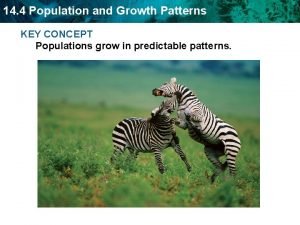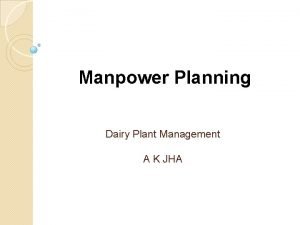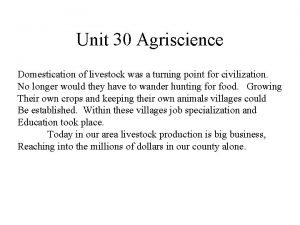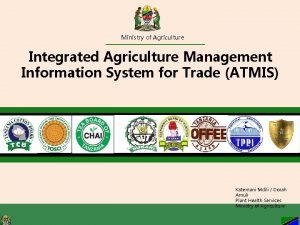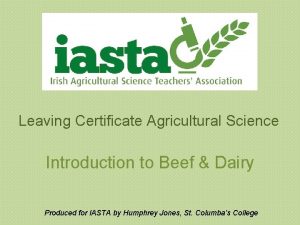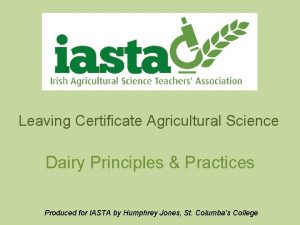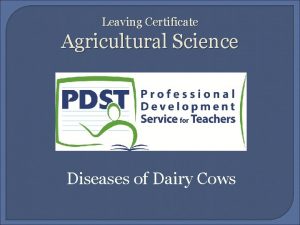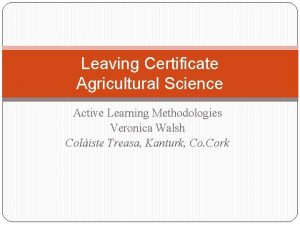Leaving Certificate Agricultural Science Dairy Herd Management Learning




















- Slides: 20

Leaving Certificate Agricultural Science Dairy Herd Management

Learning Outcomes Planning Calving After Calving Management of cow in early, mid and late lactation. Lactation Curve Total Lactation Yield. Calving Interval. Heat Detection Servicing


Introduction Planning Milk Production Milk production in Ireland is a low cost system, based on producing milk from summer grass. For this reason, 80% of all calving on Irish farms occurs in the spring. Autumn calving is rare but mainly found in areas like Dublin and Cork where there is an all year demand for milk. Creameries compensate farmers who practice autumn calving. Planning dairy management requires two major considerations:

Planning Dairy Management Planning Calving dates: All calves must be born in Jan / Feb so that best use can be made of the summer grass This requires very close attention to oestrous cycles of the herd and the use of Artificial Insemination. (AI) Balanced Grazing & Grass conservation: The amount of land allocated to summer grazing and the land set aside for winter-feeding must be carefully and accurately calculated. It must meet herd requirements. If feed shortages occur in the summer (due to not enough land being put away), yields will fall and concentrates will need to be purchased. But if shortages of silage and winter feed occurs this too will affect the herd (usually at the time of calving) So it is very important that the farmer calculates how much of his land he will use for grazing and how much for silage / other feeds.


Calving The time during calving (January and February) is one of the most important in the farmer’s calendar. The sale of calves would account for nearly 30% of the farmer’s annual income so mistakes can be costly. The most important consideration is the care of the cow before and after calving and the care of the calf at birth and the first 24 hours of it’s life. Every year 6% of all calves die at birth and another 3% in the first week. Most of these are avoidable and are caused by silly mistakes. Mistreatment of the calf can also lead to injury of the cow, lower yields or even death.

Rules for Successful Calf Management Rule 1: Isolate the cow before calving Keeping records of breeding is very important as this can help the farmer know the exact date of calving. A vet or experienced farmer should check the cow regularly before this date looking for signs of the onset of calving. The cow should be placed in a calving box 1 -2 days before the predicted date. A calving box is small-disinfected box designed simply for calving purposes.

Rules for Successful Calf Management Rule 2: Have an experienced person present. The cow should be inspected day and night to ensure that some experienced person is present when she is giving birth. Rule 3: Obtain veterinary assistance if required. An experiences farmer may handle a normal delivery, with a helper. But if any problems arise, then a vet should be contact immediately. Many calf deaths are caused by delays in seeking such assistance.


Management During Early Lactation After calving, the cow produces special milk called colostrum. This milk is not accepted in the creamery as it contains types of antibodies so the cow should not be returned to the herd straight away. The cow will continue to lactate until she becomes pregnant again (or for 2 years if suckled) but the farmer will aim for a period of 10 months. (305 days) During this 10 month period the daily milk yield will vary considerable. The LACTATION CURVE shows the typical trend during the cows lactating period.

The Lactation Curve

Management During Early Lactation The cow must be fed enough nutrients so that she reach’s her full milking potential in the period up to and including the lactation peak. This is because the level of milk produced at the peak dictates the TOTAL LACTATION YIELD. The two general rules are as follows: TLY = Daily Yield at Peak X 200 (Normal) TLY = Daily Yield at Peak X 220 (Good conditions)

Management During Early Lactation FEEDING AT THIS STAGE: The cow is fed for both maintenance and for production. The farmer can predict how much to feed an older cow for production. BUT for a first lactation cows, it is suggested to feed them higher than their yields would suggest. This is done to ensure that they reach their potential at the peak. In early lactation (FEBRUARY ON) there is not any fresh grass, so concentrates as well as silage must be fed to ensure the cow reaches her potential at the peak.

Management During Early Lactation Although this is expensive, it is worth it in the long run as the cow will produce more milk. Cows are “turned out” onto grass as soon as possible – usually around March / April. The time depends on three things: • Spring Weather • Geographical location • Fertiliser use If the grass is scarce at first, then concentrates should still be fed to keep nutrients to a high level. Care should be taken of GRASS TETANY during this period.


Calving Intervals & Heat Detection The farmer will aim to have each cow calving every 12 months exactly. To do this, the farmer must be able to detect heat (oestrous) effectively. The gestation period of cattle is 9 ½ months. (283 days) Therefore, there is only 2 ½ months after calving to get the cow pregnant, if she is to have a calf at the same time next year. Cows will come into heat 3 – 8 weeks after calving and every 21 days after.

Servicing The cow should be serviced by a bull or AI at each heat period or else essential time will be missed. Detecting heat can be quite difficult, so the herd should be observed at least four times daily Cows will attempt to mount other cows during this time so tail painting is a good method (Similar to raddling) Most servicing of cows is done by Artificial Insemination. As soon as the cow is detected as being in heat, the AI station should be informed.

Mid to Late Lactation Management Two thirds of the total yield is provided in the first half of lactation. Therefore, at this time cows are able to maintain themselves and produce milk from well-managed grassland. The yield in late lactation is so small the cow may only be milked once a day. At this stage, cows are treated with medicine to help in the drying off process. Cows are dried off 2 months before calving. In this time, the calf inside the cow will be growing very rapidly.

Mid to Late Lactation Management Therefore the cow must be fed an increasing amount of food up to calving. The cow can be fed ad lib, which means as much as possible, but should be given a crude protein ration with this up to calving. And the cycle begins again at calving. We will now look at the life of the calf from birth:
 Herd learning
Herd learning History leaving cert syllabus
History leaving cert syllabus Primary school leaving examination in chinese
Primary school leaving examination in chinese Leaving certificate
Leaving certificate A herd of elephants flies past you at sixty summary
A herd of elephants flies past you at sixty summary How much leaves and twigs an adult elephant can eat
How much leaves and twigs an adult elephant can eat Herd
Herd Acnc governance standard 3
Acnc governance standard 3 What is the movement of a single caribou into a herd
What is the movement of a single caribou into a herd Indian agricultural research institute
Indian agricultural research institute My favourite subject
My favourite subject Cuadro comparativo e-learning b-learning m-learning
Cuadro comparativo e-learning b-learning m-learning Dairy plant management
Dairy plant management Benefits of manpower planning
Benefits of manpower planning Livestock breed identification: swine - vocabulary
Livestock breed identification: swine - vocabulary Agricultural quality management
Agricultural quality management Atmis.kilimo.go
Atmis.kilimo.go Define management in agribusiness
Define management in agribusiness Cs princeton
Cs princeton Victorian certificate of applied learning
Victorian certificate of applied learning Certificate course in evidence based diabetes management
Certificate course in evidence based diabetes management








